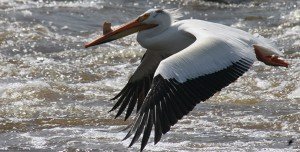 Flocks of giant white birds are catching the eyes of outdoor enthusiasts across Minnesota, as once-rare American white pelicans migrate north to their nesting grounds across the state, according to the Minnesota Department of Natural Resources.
Flocks of giant white birds are catching the eyes of outdoor enthusiasts across Minnesota, as once-rare American white pelicans migrate north to their nesting grounds across the state, according to the Minnesota Department of Natural Resources.
American white pelicans were driven to near extinction in the early 20th century from human pressures. There were no reports of nesting pelicans in Minnesota for 90 years, from 1878 until 1968.
Conservation efforts and federal regulations have helped pelican populations make a slow and steady comeback. Still, they remain one of Minnesota’s ‘Species in Greatest Conservation Need’. This designation is given to animal species whose populations are rare, declining or vulnerable in Minnesota.
“The prairie pothole region of western Minnesota hosts 22 percent of the global population of this species,” Gelvin-Innvaer said. In Minnesota, the last survey estimated about 22,000 pairs of pelicans that nest at 16 sites on seven lakes across the state. This year, another statewide survey will provide an update.
American white pelicans leave Minnesota each fall as lakes and rivers freeze. They winter along the Gulf Coast from Florida to Mexico, and typically return to Minnesota in early spring as lakes and rivers thaw.
These pelicans are among the world’s largest birds and are easily recognized in flight. Wingspans up to 9 feet, bright white plumage with black-edged wings and large, orange bills distinguish them from any other species.
“Pelicans often fly in evenly spaced lines or ‘V’ formations,” according to Lisa Gelvin-Innvaer, DNR nongame wildlife specialist. “Unlike swans or geese which fly with necks outstretched, pelicans fly with their necks doubled back against their shoulders. They often set up a rhythmic pattern of wing beats that ripple from the lead bird back to the end.”
The birds are highly social and live in large, dense colonies. They feed exclusively on small fish and crustaceans, and will work together for a meal.
“A group of pelicans will swim in a semicircle to herd their prey into shallow water,” Gelvin-Innvaer said. “Then, they’ll scoop up fish and water in their beak pouch, drain out the water and swallow their food.”
Gelvin-Innvaer advises that the birds are best enjoyed from a distance. “Pelican nesting colonies are vulnerable to human disturbance. Minimizing contact helps to conserve them as part of Minnesota’s natural heritage,” she said.
For more information on American white pelicans, visit www.mndnr.gov/pelicans.
Pelicans and many other nongame wildlife species benefit directly from donations made to the Nongame Wildlife Check off on Minnesota tax forms or online. The donations fund research, surveys, habitat restoration and education for more than 700 wildlife species that are not hunted.